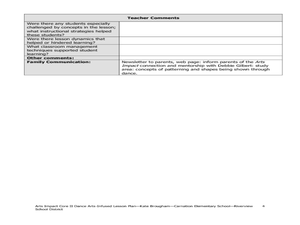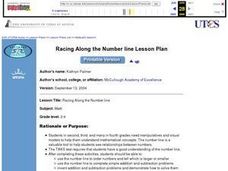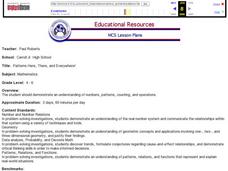Curated OER
Ten More or Ten Less
Adding and subtracting 10 is easy once you understand the tricks! Learners first write numbers that are ten more than two double-digit numbers. Then, they find numbers ten less than two other double-digit numbers. An explanation on the...
Curated OER
Counting in Tens From a Given Number
In this counting learning exercise, students fill in the spaces on the learning exercise by counting by ten. There are 6 number patterns to complete, and each has 5 blanks to fill in. The answers are on the last page.
Curated OER
Skip Counting
In this math worksheet, students complete 6 number patterns in which students fill in the missing numbers while skip counting. The addition pattern is already indicated for students. All numbers on the page are between 1 and 35.
Curated OER
Design Patterns in Everyday Life
Students find symbols and patterns in everyday life. In this patterns lesson, students break into groups and look for specific patterns and symbols. Students record their findings. Students create a graphic organizer with the information.
Curated OER
Counting by 3s, 4s, and 5s
Can learners recognize the pattern in these number sequences? Here's a hint: it's skip counting by either three, four, or five. There are three examples at the top demonstrating each of these, and scholars complete 15 number sequences to...
Curated OER
Patterns With Sounds and Motions Challenge
In this recognizing patterns worksheet, students identify the sequence of pictures with sounds and motions, and choose the one that is likely to come next. Students solve three answers.
Curated OER
Venn Diagrams, Part 3
Can your first graders interpret Venn diagrams? Different sets of clues help pupils narrow down a specific number in different shapes. They determine odds and evens, greater than or less than, and what shape the number is in. A fun...
Curated OER
Color By Number
Math pages that involve coloring are fun and can help children differentiate patterns or specific information. They compute single-digit addition problems that result in sums from 10 to 15. Odd numbers are colored red and even...
Curated OER
Number Sequence Rules
In this number sequence interactive worksheet, learners fill in the missing numbers in each of the 14 number sequences. There are three numbers missing in each number sequence.
Curated OER
Dancing Polygons and Non-Polygons with Patterns
Second graders study movements. In this dance lesson, 2nd graders draw patterns selecting one to represent through movement with their body.
Curated OER
Odd And Even Numbers
Second and third graders identify odd and even numbers. They analyze a group of numbers and circle the odd number in each group. Pupils do the same with even numbers. This page has no explanation and there are no examples. Prior...
Curated OER
Racing Along the Number Line
Manipulatives and visual models really help youngsters understand mathematical concepts. One activity provided here gives every learner their own white board and accompanying number. Then learners have to put themselves in order, holding...
Curated OER
Hands Up Math
Learners engage in a instructional activity that is concerned with the concept of using all four operations in order to create numerical expressions. They practice creating various patterns of problems that could be solved. The...
Curated OER
Ten More or Ten Less
This set of problems has learners complete a variety of tasks as they practice adding 10 and subtracting 10. An apple tree with two apples isn't very fun; how about one with ten more? They draw the apples onto the tree and write the...
Curated OER
Algebraic Processes And Its Connections To Geometry
Youngsters explore number patterns within a Hundreds Chart. They discover six specific patterns from six teacher-directed rules in cooperative groups and describe in words ONE of the three patterns in their Learning Logs. They prove for...
Curated OER
Number Pattern Challenge
In this number patterns worksheet, students practice recognizing patterns. Students determine the number pattern and complete the pattern by inserting the last two numbers. There are ten problems in all, and an answer sheet is included.
Curated OER
Number Patterns Challenge
In this number patterns worksheet, students practice recognizing patterns. Students determine the number pattern and complete the pattern by inserting the last two numbers. There are ten problems in all, and an answer sheet is included.
Curated OER
Sequences
Provide your class with a comprehensive set of examples that help define sequences. They view a wide variety of sequences that range from animals, to letters and sounds. They work through each sequence to determine what should come next....
Curated OER
Ocean Exploration: Shapes and Patterns Under the Sea
So many shapes in our vast oceans. Young explorers can discover new shapes in a variety of ways in this lesson. One way is having free exploration with a pattern shape kit handed out by the teacher. Another is by viewing a...
Curated OER
Arithmetic Patterns
Introduce your young math scholars to functions. Because the answer is explained at the bottom of the page, consider projecting this and covering it up until you hear the class responses. They observe a rule (in this case to add 15) and...
Curated OER
Arithmetic Patterns
Pupils experience math functions as they practice their addition and subtraction skills, and fill in each table based on a given rule. There are two columns in each of the four tables. The in column is already completed and...
Curated OER
Patterns Here, There and Everywhere
Pattern recognition is a skill often used in mathematics. Learners count and sort manipulatives, organize the data into a graph and answer questions about the information displayed. They collect the objects to be used and create patterns...
Curated OER
Add It Up In Number Ville! Adding 2-Digit Numbers With and Without Regrouping
Students explore adding 2-digit numbers. In this math lesson, students identify 2-digit numbers and use base ten blocks to practice adding. Students use addition to break a code.
Curated OER
Addition Properties
Addition becomes much simpler once scholars understand its properties. They examine the commutative property through five equation pairs. For each, the addends have been switched and scholars must fill one in. The next six...























